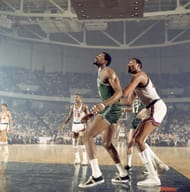
Friends and foes: Bill Russell (L) and Wilt Chamberlain (R) pictured here in 1968 in one of their famous on-court duels. (Getty Images)
As a kid, he had always shown an aptitude for athletics as he managed to high-jump 6’6” inches, run 440 yards in 49 seconds, could put the shot to around 53 feet and also long jump around 22 feet. Basketball was a natural fit to Chamberlain, because growing up in Philadelphia it is but natural to gain an affinity for the sport.
But to Chamberlain the game of basketball was just always about the skill and the athleticism involved. The mental part of the game was never really his forte. He wasn’t the unrelenting warrior that Russell was, because in his mind he didn’t need to do that. Chamberlain was happy being the razzle-dazzle pure finesse guy, but to the purists he was never the cold-nerve Championship winning player.
Explore the NBA Draft 2024 with our free NBA Mock Draft Simulator & be the GM of your favorite NBA team.
Chamberlain often would go soft on his opponents because he was scared of hurting them. In his entire career, he was never fouled out in a single game and despite being hacked by double-teams and triple-teams his entire career, he very rarely lost his cool and reacted to the physicality.
Chamberlain was however disturbed because he believed that such antics didn’t allow him to play the game to the best of his abilities, and such reasons were behind his asinine decisions to quit college to join the Harlem Globetrotters, or to plan to retire after his first season with the Warriors.
In the 1970 NBA Finals, Chamberlain and the Lakers faced up against a hobbling Willis Reed, and a New York Knicks team that was disenchanted by the injury to their franchise star. Reed was by no means 100%, but Chamberlain rather than treating it as an opportunity to hit the final nail in the coffin, was rather charitable to Reed.
Reed didn’t score a lot, but the presence of their leader gave the Knicks vital confidence, something that translated in their mauling of the Lakers. Post the contest, Russell openly stated that if he were in Chamberlain’s place, he would have snuffed out Reed, gotten to his face and under his skin and killed off any chance of him having an impact.
Chamberlain was however different. Many a times in his career, he would not go up to block a dunk in fear of the fact that he may break the player’s arm. Maybe the image haunting him was the 1966-67 season when the Warriors were playing against Baltimore.
Gus Johnson (6’6”, 230 pounds) tried to dunk on Chamberlain in a one-on-one transition. As Johnson cupped the ball and took off, Chamberlain went up and with one hand he grabbed the ball. Johnson was flattened by the impact; they had to carry him out. It was later revealed that he suffered a dislocated shoulder due to the collision.
Chamberlain was a much bigger team player than he is given credit for. When Alex Hannum, then coach of the Philadelphia Warriors tried to convince Chamberlain, that the team needed him more as a defensive force and he needed to become more of a facilitator than a scorer, he was more than happy to do the same.
Chamberlain ended the season averaging over 24 points, 24 rebounds and over 8 assists en route to leading the team to the NBA title. When Bill Sharman asked him to play like Russell, Chamberlain ended the season averaging just 15 points, 19 rebounds leading the team to a record 33-game winning streak.
Chamberlain did end his career with two rings, a small feat compared to his nemesis Russell, who finished with eleven. He wasn’t hated for who he was, but because many thought he was a glory-hunter.
Chamberlain may have pulled the crowds and made a lot of money but everywhere he played and every single arena he went to, people wanted him to fail. They celebrated his failures much more than Russell’s victories.
Did Chamberlain care? Yes. He did care, maybe a little too much.
Los Angeles Lakers Fan? Check out the latest Lakers depth chart, schedule, and roster updates all in one place.
